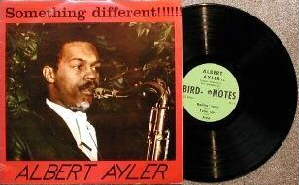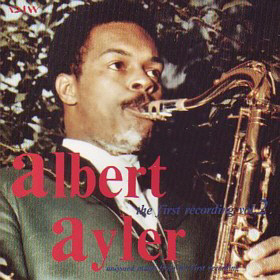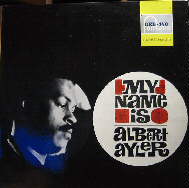Startseite › Foren › Über Bands, Solokünstler und Genres › Eine Frage des Stils › Blue Note – das Jazzforum › Albert Ayler › Re: Albert Ayler
Ich höre nun also die allerersten eigenen Aufnahmen von Albert Ayler, die am 25. Oktober 1962 in Stockholm entstanden sind mit dem Bassisten Torbjorn Hultcrantz und dem Drummer Sune Spangberg.

Sehr bemerkenswerte Musik! Die Rhythmusgruppe ist offen, geht mit Ayler mit, durch das Fehlen eines Harmonieinstrumentes hat die Musik viel Raum, den Ayler nutzt, sein Ton ist schon hier höchst unkonventionell, von den späteren Elementen fehlt vor allem das parodistisch-kitschige (das Ayler ja bestimmt ernst gemeint hat als Mittel der Expression, aber ich kann’s nicht besser beschreiben).
Die Setlist der beiden LPs ist ziemlich konventionell auf den ersten Blick. Die Standards „I’ll Remember April“, „Softly as in a Morning Sunrise“ und „I Didn’t Know What Time It Was“, die Originals „Tune Up“, „Moanin'“, „Good Bait“, ein einziges Ayler-Stück namens „Free“ (laut Brian Priestley wohl ein Take von „Moanin'“, bei dem das eröffnende Thema fehlt), sowie die Paradenummer Aylers, das simple Sonny Rollins Thema „Sonnymoon for Two“ (das hier unter dem Titel „Rollins‘ Tune“ fungiert). Das thematische Material bildet durchaus den Ausgangspunkt für die Soli, aber Ayler geht in seiner ungehemmten Expressivität, den Flektionen und Multiphonics weit über konventionelles „jammen“ hinaus. Die Rhythmusgruppe hört zu, ist flexibel was das Tempo und die Dichte der Begleitung betrifft, setzt manchmal fast völlig aus, treibt dann die Musik wieder voran. Das Begleitgespann war schon seit einiger Zeit miteinander vertraut, hatte in der Gruppe von Bernt Rosengren gespielt und auch Bud Powell während Auftritten in Schweden begleitet. Gegen Ende des langen Textes von Marc Chaloin wird Spangberg aus einer Erinnerung, die er 1992 verfasst hat, zitiert:
But now, together with Albert Ayler, this whole experience was a matter of an entirely different way of traveling. For sure, I have never experienced such ease of flying. Everything about it was like a giddy adventure of bearing or bursting. Can we feel the ground? Are we keeping it up? Is my time right? Are the harmonic patterns okay? And at the same time, that relaxed, self-evident reciprocity. … Audacious phrasing and capricious rhythmic groupings, often with unexpected leaps and displacements, made it so that the form itself was broken up to float in suspension. Ayler moved with superb freedom in a music that was transparent and seemingly without bar lines. What deliverance and release to yield to all this as a participant! Like being lifted up high and empowered to discern unending possibilities! A spontaneous and unhesitating flood of inspiration, at the same time conscious and unconscious. Like a blessed gift of grace–it isn’t I who is playing–I allow myself to be played. But if for a moment I would ask myself how this condition is possible, logically to seek to understand how it happens–then in an instant I would lose everything, the wholeness is broken …

Die Komplizenschaft hört man der Musik durchaus an und das grenzt sie auch ab von der Aufnahme des folgenden Jahres, die als „My Name Is Albert Ayler“ erschienen sollte. Jedenfalls wird hier bei allem Epigonentum – Sonny Rollins‘ motivische Improvisation stand bestimmt Pate! – deutlich, wohin Ayler unterwegs war, und dass es auch 1962 in Europa bereits Musiker gab, die gewillt und einigermassen in der Lage waren, diesen Weg mitzugehen.

Niels Bronsteds Erinnerung an die Kopenhagener Session im Januar 1963 liest sich (auch wieder aus Chaloins Bericht) ziemlich anders:
As for Brønsted, he frankly admits that he „couldn’t relate to [Ayler’s] style of music“ and that he did not like the record at all: „I think it is embarrassing to hear. … But especially my own playing is horrible on that record.“ The pianist-turned-theosophist (he quit playing music in the mid-’70s) liked Ayler as a person but is skeptical as to the extent of his technical abilities–something he finds very difficult to evaluate in a musician who plays so differently from everybody else. „Because you don’t know if what comes out of the horn comes out voluntarily or by chance. I think a little bit of both. … But I don’t think he was completely in control of what was happening with his fingers … He was more like a big heart trying to expressing himself through a limited ability.“ Brønsted nonetheless concedes that Ayler had „a certain control of his tone, histone color or what you call it: the harmonic sound of his horn,“ as well as „a lot of things to express,“ and that „on ‘Summertime’ maybe, he said some of them.“
Vor dem Hintergrund der drei 1962/63er Sessions (die erste fand im Juni in Helsinki mit Herbert Katz statt – siehe oben) wird auch die herausragende Bedeutung klar, die den 23 Minuten zukommt, die im November 1962 mit Cecil Taylors Trio dokumentiert worden sind, sie sind in der Tat das „missing link“:
Historically speaking, this 23-minute performance is the first recording from anywhere in the jazz spectrum of a long-form improvisation with no overt synchronization – of time, structural harmony, or song. That may seem merely statistical, but while the fact is an important milestone, the real story is that Taylor-Lyons-Murray + Ayler could play in an artistically meaningful free space with such balance and fluidity. „Four“ is, as tenor saxophonist Mats Gustafsson has put it, the missing link.
~ Ben Young, The Sessions, Liner Notes zu: Albert Ayler, „Holy Ghost: Rare & Unissued Recordings (1962-70), Revenant, ca. 2004, S. 140
In dieser einen Aufnahme mit Taylor kommt alles zusammen, was Aylers Musik ausmachen würde – zum ersten Mal. Der Kontrast von Lyons apollonischem und Aylers dionysischem Approach funktioniert zudem wunderbar und bringt – auch im Vergleich mit den grossartigen Aufnahmen, die auf „Nefertiti“ dokumentiert sind – eine wesentliche Bereicherung für den Sound der damaligen Cecil Taylor Unit.
--
"Don't play what the public want. You play what you want and let the public pick up on what you doin' -- even if it take them fifteen, twenty years." (Thelonious Monk) | Meine Sendungen auf Radio StoneFM: gypsy goes jazz, #169 – 13.01.2026, 22:00 | Slow Drive to South Africa, #8: tba | No Problem Saloon, #30: tba